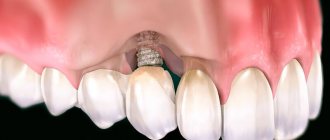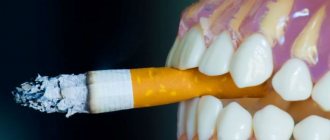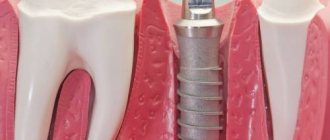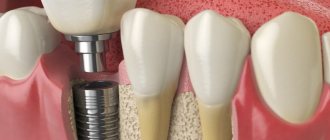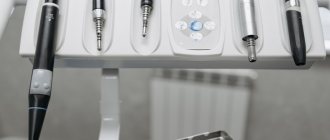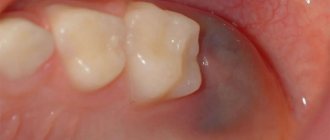Losing a tooth, or even several, is not a death sentence to a toothless life. Implantation is one of the most popular methods for restoring the functionality of lost teeth. In place of the native root, an implant is implanted into the bone tissue - a titanium screw, which will serve as a support for the crown.
Healing after implantation, like after any other surgical procedure, takes some time. The rehabilitation period depends on various factors: age, characteristics of the body, the professionalism of the doctor, the presence of chronic diseases, and compliance with recommendations for oral care.
Types of materials for sutures in implantology
Dental practice uses several types of suture materials. All of them are classified into self-absorbable and non-absorbable.
Absorbable include
- Catgut;
- dexon;
- vicryl.
Catgut has been used for more than a century and is a classic. The threads dissolve in about two weeks due to the action of phagocytosis and enzymes. The disadvantage of the material is the ability to provoke tissue inflammation due to foreign proteins contained in its composition. The use of catgut during implantation is not recommended.
Dexon and vicryl are synthetic materials. The active substance of the first is polyglycomic acid, the second is polylactin. Resorption is promoted by hydrolysis. The period of complete dissolution takes about a month. Suppuration practically does not occur when using these threads.
Non-absorbable threads
- Silk;
- woven polyester;
- monofilament.
Silk , consisting of silkworm proteins, is often used by surgeons, but not for fixing bone grafts. It has one drawback - sometimes an inflammatory process develops in the area of the sutures. Braided polyester threads serve their purpose well, without complications.
Monofilament sutures with good mechanical properties are most suitable for implantology They do not cause reactions and are suitable for prolonged contact with the oral mucosa. The only negative aspect of the material is the rough ends. The problem is solved by fixing them with a special bandage.
Installation of the crown part
The penultimate stage of implantation is prosthetics (building up the crown part of an artificial tooth). It is carried out 1–2 weeks after fixation of the abutment. May take different times depending on the type of crown chosen. Options:
- removable denture (budget option, justifies itself when replacing 4 or more teeth);
- fixed dentures (bridge or single);
- conditionally removable;
- combined options.
Regardless of the choice of prosthesis, its preparation is carried out in several stages. In the first step, the orthodontist makes an impression of the jaw. The procedure takes no more than 10 minutes and is performed without pain or discomfort. Necessary for making a crown of the correct shape and size in accordance with the structure of the jaw.
The second stage is the production of prostheses. The patient is not involved here. Crown elements are performed in the laboratory of the selected clinic within 2–4 weeks, depending on the choice of material (metal-ceramics, ceramics, precious metals).
At the third stage, a series of fittings and adjustments of the prosthesis to the patient’s bite is carried out. As soon as this process is completed, they are installed (using special locks if this is a removable model, or adhesive material if the dentures are permanent).
Care instructions
Regular treatment of the operated mucosal area promotes successful healing. The procedure consists of several stages.
- Daily three-time antimicrobial rinses with Tantum Verde solution.
- To protect the tongue from damage by the hard ends of the threads, it is necessary to smear the operated area with Solcoseryl adhesive paste. It promotes rapid regeneration of the damaged area.
- Drug therapy includes taking Calcium d3 Nycomed, multivitamin complexes, painkillers (if the gums hurt). Anti-inflammatory drugs are prescribed to reduce swelling.
Additionally, the following rules must be observed:
- give up solid food, hot dishes, drinks, hot spices, coffee (increases blood pressure);
- do not use a hard toothbrush;
- avoid intense training and heavy lifting;
- do not visit the sauna, bathhouse;
- stop smoking: cigarette smoke negatively affects the mucous membranes and increases the risk of inflammation.
- The diet should include pureed soups, boiled porridges, and broths.
It is important to maintain oral hygiene to avoid the proliferation of pathogenic microorganisms. You need to brush your teeth carefully, without touching the operated area.
Features of implantation
Implantation is used to restore the functionality and aesthetics of the dentition. The procedure involves screwing the implant into the bone, which requires first making an incision in the gum. The process is traumatic, requiring the following operations:
- tissue preparation, making an incision on the gum and periosteum;
- drilling a bed into the bone to install the structure;
- screwing the implant into the prepared hole;
- suturing soft tissues.
Normally, discomfort and pain go away within a couple of days, and the stitches are removed after a week. But if the patient violates the care recommendations or for other reasons, the stitches may come apart. This is accompanied by increased pain, swelling, and the development of inflammatory processes.
What to do if the suture breaks after implantation
There are times when the threads have weakened and come apart. This does not threaten the implant falling out, but there is a risk of infection . The situation must be corrected urgently.
After the examination, the doctor will take the necessary antiseptic measures and prescribe rinses. The recovery period after long complex operations is sometimes accompanied by antibiotic therapy. The rehabilitation course for each patient is compiled individually. If the tissues have not yet fused, the specialist will have to remove the stitches and then apply new ones.
Causes of seam divergence
The seams after screwing in the implant may come apart for various reasons. The main ones are:
- the patient violates the doctor’s recommendations regarding care of the postoperative area;
- poor oral hygiene;
- the doctor made a mistake when performing treatment and used low-quality materials;
- individual intolerance to the materials used;
- serious damage to the jaw bone.
Suture removal after implantation
Patients are always interested in the question “On what day after implantation are the sutures removed?” Usually, for those whose healing went well and there was no suppuration, the threads are removed after 10-14 days. All this time, the area above the implant must be treated with antiseptics and protected from injury. The first days after surgery, you may feel as if threads are being pulled. Often there is a discharge of ichor. After the thread extraction procedure, which is absolutely painless, the doctor will recommend continuing the preventive course.
Introduction
We hope you did everything correctly before implantation, carried out all the necessary tests and diagnostics, prepared comprehensively, and now, after its successful implementation, all that remains is to follow the following recommendations after dental implantation.
But, if you are just preparing for dental implantation, then all the materials in this section will be extremely useful to you. And if you want to place implants with the highest quality and reliability, we recommend contacting our Research Center clinics, which have been successfully operating in Moscow for more than 10 years. And they are the best not only in Moscow, but also in Russia according to dental ratings. Sometimes it is better not to skimp on your health, since you will live with implants for the rest of your life, and the quality and further maintenance of implant systems should come to the fore. Remember the simple folk truth “The miser pays twice”: poorly installed implants can lead to their rejection and inflammation of the bone tissue. Yes, installing implants with us is not cheap, but we solved this problem for you!
Financial support for dental implantation
Do you want to undergo high-quality dental implantation in our clinics, but have a financial problem? This can be solved! From July 20, 2020
You can also use the dental implantation service in installments.
note
that some of the material is accompanied by a video from our YouTube channel, we recommend spending a little of your precious time and watching the videos, it will be useful.
More than 1,000 patients
use the recommendations of medical specialists from the Research Center on YouTube every day .
Why is it important to follow the recommendations after implantation?
Firstly
, dental implantation is a serious surgical intervention involving bone tissue deformation. And it takes time for the bone structure to heal. The recommendations of the attending physician allow the bone tissue to heal and osseointegrate into the dental implant as quickly as possible. Do you know what can result from the fact that the implant does not take root due to your failure to follow the recommendations? Let's read the next point #2, which is also the most important. And this is not a joke, but the sad experience of violating patients.
Secondly
, non-compliance with recommendations sharply increases the risk of developing inflammation at the implant site - peri-implantitis, followed by implant rejection or removal. Moreover, inflammation can occur both in the first months after installation of the implant, and after a year or two or three. Below we provide clinical examples of peri-implantitis that developed in patients, leading to the removal of the implant. Therefore, be careful and follow the recommendations.
In general, high-quality dental implantation is absolutely painless for the patient. The importance and role of implantation in human health cannot be overestimated. The biggest problem with implantation is that there is swelling after the operation. It can last for about 3 days
, but even then not always.
After dental implantation, the patient must understand that he will have a certain medication load: he must take antibiotics, antimicrobial drugs, and take baths with an antiseptic. And, of course, follow the doctor’s recommendations.
What to do next
The implantation process is quite long. After the threads are removed, the mucous membrane continues to grow over the implant. It shouldn't be visible. This takes approximately two months. Then prosthetics are performed. Installed orthopedic structures require careful care. The patient needs to master the technique of daily procedures that will help maintain a beautiful, healthy smile for a long time. These include:
- using a brush with soft bristles;
- brushing teeth twice a day;
- flossing;
- cleaning the areas where the implants come into contact with the gums using an irrigator;
- If plaque has formed, visit the dental office to remove it.
Patients who have undergone implantation should periodically visit specialists. This will help extend the service life of structures and avoid complications.
Installation of the healing abutment
A gum abutment is a temporary structure that is placed to create a natural contour around artificial teeth. It is a titanium cylinder that is screwed into a pin and worn for at least 2 weeks. Installation of the former is performed under local anesthesia, takes up to half an hour (incision - fixation - suturing) and also requires rehabilitation (from 4 days).
How long does it take for tissue to recover and implants to take root?
How long it will take for the gums to recover depends on the method of implantation and the general health of the patient. If there were incisions and sutures were placed, then healing takes a little longer than with a minimally invasive installation (using the gum puncture method). But on average this period takes 3-7 days.
As for the engraftment of classical implants, osseointegration or dense growth of bone tissue over the entire surface of the implant takes about 3-6 months. If advanced models with active coating and drugs that stimulate bone growth were used, osseointegration can occur very quickly - in just 2-6 weeks.
Much also depends on when exactly the prostheses will be placed on the implants. With the traditional approach or two-stage implantation, the prostheses are fixed after complete osseointegration - i.e. 3-6 months after surgery. But when implanting with immediate loading, the prostheses are installed immediately or 3-4 days after the operation. Here, osseointegration is accelerated due to the chewing load transmitted along the “prosthesis-implants-bone” chain, which activates the formation of new capillaries and the growth of bone tissue around the implants.
The healing of soft tissues and the engraftment of implants also depends on how carefully the patient follows the recommendations of the implantologist during the postoperative period of dental implantation. We'll talk about this later.
What is a surgical guide for implantation? Why is he married? Is it included in the cost of the operation?
A surgical template is a special device for the correct installation of implants, which is usually made by an orthopedic dentist at the stage of planning the operation. In fact, the task of any surgeon performing an implantation operation comes down to the correct protocol installation of the “screw”. But an implant is not an end in itself, it is only an intermediate stage of prosthetics. Those. The implant placed by the surgeon still needs to be somehow fitted with a crown or some other structure. And here it is very important that the implant not only “grows” to the bone, but also stands correctly. What does right mean? In the right place, with the right slope, at the right depth... i.e. it should not just be placed “by eye” of the implantologist, but oriented in a certain way. Because later it may turn out that the implantologist has his own “eye”, and the prosthetist has his own. So, just so that both doctors, working together for a single result, understand each other, a template is necessary. It most often looks like a removable denture.
This is what one of the surgical template options looks like. During the operation, the implantologist will position it in exactly the same way and will no longer be able to place the implant crookedly and in the wrong place where the orthopedist needs it.
To make it, the prosthetist must take impressions in advance and clearly plan the position of future crowns, so that later it does not turn out that the implants are in the wrong place. This is especially important when carrying out large operations, when a large number of implants are placed, and the surgeon does not have any landmarks in the form of neighboring teeth. It is also very important to have a template in anterior surgeries when it comes to achieving maximum aesthetics. If there is a template, the surgeon will apply it to the surgical area during the operation, and then there will be no need to guess how exactly to orient the implant in 3-dimensional space.
A surgical template, as a rule, is not included in the cost of the operation, since, despite everything written above, it is not needed in 100% of cases.
And now I want to show a clear example of what results can be obtained without planning the installation of implants.
This photo shows the sad result of illiterate installation of implants. A young girl lost her front teeth due to injury and the surgeon decided to give her implants without planning treatment with an orthopedist. Just a couple of weeks after the prosthetics, the patient realized that with such teeth she could not smile normally. The result of the treatment was absolutely disastrous from an aesthetics point of view, although both implants took root well.
The reasons for this result are clearly visible here. The implants were placed according to the scheme “like the surgeon’s right hand itching.” They are installed at different angles, at different depths, without taking into account the need to form the correct gingival contour. In this case, an implant system was used, which has limitations in the possibilities of prosthetics, so it is impossible to correct the situation with crowns. Unfortunately, in this case, the only option to fix everything is removal of the implants, bone grafting and re-implantation.
After removal of the implants, the patient was given a banal temporary removable denture (the so-called “bird”), the aesthetics of which are much better than the previously installed crowns on implants.
How to distinguish normal consequences from complications?
Here you should be wary if the following conditions are noticed:
- the pain does not subside, but persists or even intensifies in the days following the operation,
- the swelling is very large, does not go away for a long time or appears again after it subsides,
- bleeding is very heavy and does not decrease within 4-6 hours,
- body temperature rises sharply above 39 degrees Celsius, and also, if it does not return to normal after 4-5 days,
- the appearance of pus from under the gums,
- bad breath,
- obvious tissue numbness persists for more than 3 days: this may no longer indicate compression (squeezing) of the nerve, but its damage, which requires specific therapy,
- mobility of implants or prostheses, as well as their loss,
- seam divergence,
- It is painful or impossible to chew food with installed dentures.
Any of the above conditions is a reason to immediately consult a dentist.
